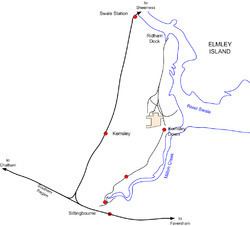Dates of operation 1906–1969 Length 16,093 m | Track gauge 2 ft 6 in (762 mm) | |
 | ||
Bowaters paper railway visited 1962
The Bowaters Paper Railway was a 2 ft 6 in (762 mm) narrow gauge industrial railway. It had the distinction of being the last steam-operated industrial narrow gauge railway in Britain when it closed in 1969.
Contents
History
The manufacture of paper at Sittingbourne dates back to the seventeenth century. The paper mill was originally supplied with raw materials by barges that sailed to wharves at the head of Milton Creek. A short horse-hauled tramway moved pulp to the mill. Two steam locomotives were introduced in 1908.
In 1913, as Milton Creek began to silt up, the paper making company began work on the construction of Ridham Dock, a deepwater facility on the Swale estuary, where seagoing ships could unload raw materials and load finished paper products. At the start of the First World War the railway and the dock was taken over by the Admiralty and the railway was extended to connect the dock. After the end of the war the railway was returned to the paper company. In 1924 a second paper mill opened at Kemsley Down, and further extended in 1936. By this time, the railway reached its maximum length of 10 miles (16 km).
Closure, preservation and uncertain future
In 1969, a time and motion study by the then owners, The Bowater Paper Corporation (Bowater), resulted in the closure of the railway which, arguably, should be called Bowater Paper's Railway. By this time the railway was the last industrial narrow gauge railway in Britain operating steam locomotives and, until withdrawn from 30 September 1968, had operated a scheduled passenger service for its employees between the Sittingbourne mill and Ridham Dock. Bowaters had a "handing over" ceremony to the news lessees, the Locomotive Club of Great Britain (LCGB), on 4 October 1969 but continued running its goods trains until the final one on 25 October 1969. The LCGB was granted a lease of the southern portion of the railway between Sittingbourne and Kemsley Down in 1970. Much of the rest of the equipment went to form the Great Whipsnade Railway. The LCGB formed the Sittingbourne and Kemsley Light Railway Company to operate the railway. The company operates the railway under the name Sittingbourne & Kemsley Light Railway (S&KLR).
The S&KLR was threatened with closure at the end of 2008. The current owners of the railway land, the Finnish paper company M-real, closed the paper mill at Sittingbourne in 2007 and sold the paper mill at Kemsley to another company. M-real gave the railway company notice to quit the site and to remove all their locomotives and equipment by the end of December 2008. After a brief period of opening in October 2010, the railway began operations again in the summer of 2012. As of June 2015, the railway is operating yearly from Late March to the end of September.
